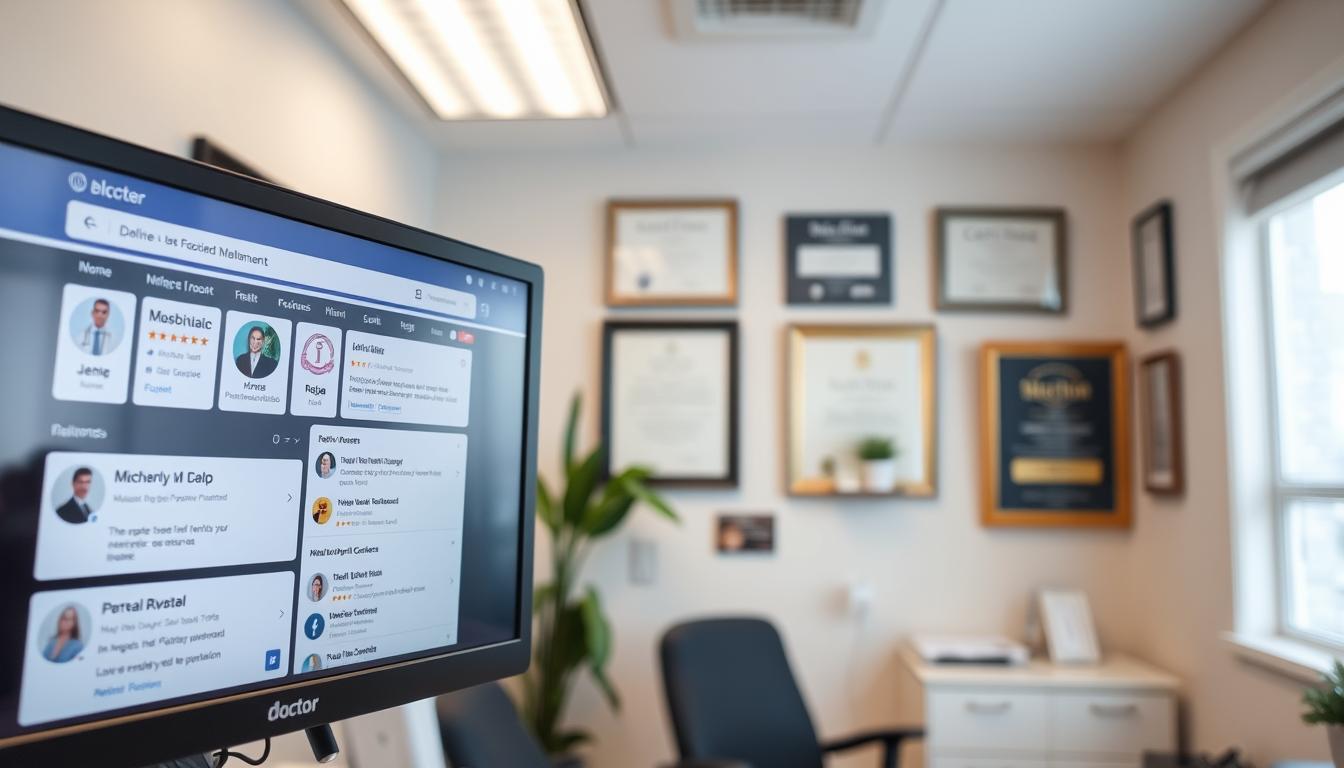A doctor’s reputation is more vulnerable than ever. With 69% of people searching for local businesses online at least once a month and 94% using online reviews to evaluate healthcare providers, maintaining a positive online presence is crucial. A damaged reputation can significantly impact a doctor’s ability to attract and retain patients, ultimately affecting their practice’s sustainability.
At Reputation Return, we understand the challenges medical professionals face in managing their online reputation. That’s why we offer a free and confidential consultation to address these concerns and provide tailored solutions. Our expertise in reputation management helps restore credibility and patient trust, ensuring long-term practice growth.
A strategic online reputation management plan is essential for navigating the complexities of digital scrutiny. By monitoring online reviews, engaging with patients, and optimizing social media presence, doctors can protect their practice and build a resilient reputation. This article will explore actionable strategies to address these challenges and provide a clear path to recovery.
Key Takeaways
- A doctor’s online reputation directly impacts patient acquisition and retention.
- 94% of patients use online reviews to evaluate healthcare providers.
- A strategic reputation management plan is critical for long-term practice success.
- Engaging with online reviews can enhance a doctor’s reputation.
- Reputation Return offers a free, confidential consultation to address reputation challenges.
Understanding Online Reputation in Healthcare
Online reputation plays a pivotal role in shaping the success of healthcare providers in today’s competitive landscape. With almost 69% of consumers searching for doctors online and 94% of patients using online reviews as a first step in choosing a physician, the digital footprint of a healthcare provider is more critical than ever.
The Role of Online Reviews in Patient Decisions
Online reviews significantly influence patient decisions when selecting a healthcare provider. A 4.7-star rating with numerous positive reviews can make a practice stand out, while a lower rating may deter potential patients. 75% of patients will only consider doctors with a rating of 4 stars or higher, highlighting the power of reviews in shaping perceptions.
Current Trends and Statistics
Positive and negative reviews shape a doctor’s reputation online, with platforms like Google and Facebook playing crucial roles. 59% of consumers read Google My Business reviews, making it a vital platform for healthcare providers. Additionally, 81% of patients consider online reviews before choosing a physician, underlining the necessity of proactive review management.
Negative reviews can have a detrimental impact on a doctor’s practice, potentially leading to patient loss. However, responding to reviews can mitigate risks and enhance trust. Tools like Google Alerts allow monitoring of online mentions, helping healthcare providers stay informed and address concerns promptly.
Effective reputation management involves more than just monitoring reviews. It requires a strategic approach to engage with feedback, ensure accurate online listings, and leverage positive reviews in marketing efforts. By doing so, healthcare providers can build a resilient reputation and attract more patients in a competitive market.

To learn more about how we can help you manage your online presence, visit us at Reputation Return. We specialize in providing tailored solutions to protect and enhance your digital reputation.
Key Elements of Reputation Management for Doctors
Managing a doctor’s online presence is a multifaceted task that requires attention to detail and proactive strategies. Effective reputation management involves monitoring patient feedback, ensuring accurate information, and leveraging multiple media channels to shape public perception. By implementing these strategies, healthcare providers can build trust and maintain a positive image.
Monitoring Patient Feedback and Online Presence
Monitoring patient feedback is crucial for understanding how your practice is perceived online. Tools like Google Alerts can help track mentions across the web, while platforms like Yelp and HealthGrades specialize in patient reviews. Regularly reviewing this feedback allows you to address concerns promptly and showcase your commitment to patient satisfaction.
| Platform | Monitoring Tips |
|---|---|
| Google My Business | Respond to all reviews, both positive and negative, to show engagement and care. |
| Yelp | Claim and optimize your profile with accurate practice information. |
| HealthGrades | Monitor ratings and respond professionally to feedback. |

Maintaining Accurate and Transparent Information
Consistency is key to a strong online presence. Ensure your practice’s Name, Address, and Phone number (NAP) are accurate across all directories. Regular audits of your online profiles help prevent discrepancies that could confuse patients. Transparency in your online information fosters trust and can mitigate the impact of negative feedback.
How to Achieve Reputation Repair for Doctors
Building trust is a cornerstone of any successful medical practice. In today’s digital landscape, where patients heavily rely on online information, proactive strategies are essential to foster trust and maintain a positive image.
Establishing Trust Through Proactive Strategies
A well-crafted approach to managing your online presence can significantly enhance patient trust. By addressing feedback promptly and ensuring accurate information, you demonstrate commitment to patient care and satisfaction.
| Strategy | Actionable Steps |
|---|---|
| Monitor Online Feedback | Use tools like Google Alerts to track mentions and respond to reviews on platforms like Google My Business and Yelp. |
| Provide Accurate Information | Ensure consistent NAP (Name, Address, Phone number) across all directories and update your website regularly. |
| Engage with Patients | Share patient testimonials and success stories on your website and social media to showcase real experiences. |
| Offer Transparent Communication | Post regular updates on your website and social media about practice news, achievements, and educational content. |
By implementing these strategies, you create a trustworthy online presence that attracts and retains patients. A well-maintained website serves as the hub for accurate and up-to-date practice information, reinforcing your commitment to patient care.
For more insights on managing your online presence, visit Reputation Return. We specialize in helping healthcare providers protect and enhance their digital image.
Enhancing Your Digital Presence with Strategic Content
Creating high-quality, engaging content is essential for building a strong online presence. Strategic content marketing helps healthcare providers establish authority, foster trust, and attract more patients. By sharing valuable information, doctors can position themselves as experts in their field while addressing patients’ concerns.
Doctor Blogging and Educational Content Creation
Regular blogging is a powerful way to boost your digital presence. Writing about topics relevant to your specialty not only educates patients but also enhances your site’s visibility on search engines. For example, a blog post about “Understanding Diabetes Management” can attract individuals searching for related information, driving organic traffic to your site.
Educational content fosters trust by demonstrating your expertise. When patients feel informed, they are more likely to leave positive reviews, which strengthens your online presence. Sharing patient success stories and case studies adds a personal touch, making your content more relatable and engaging.
Leveraging Videos and Social Media Engagement
Videos and social media are key to broader engagement. Short educational videos on platforms like YouTube or Instagram can explain complex medical topics in an accessible way. Engaging with followers through comments and direct messages builds a community around your practice, encouraging patient interaction and loyalty.
| Content Strategy | Benefits |
|---|---|
| Blogging | Improves SEO, establishes expertise, and attracts patients. |
| Educational Content | Builds trust and encourages positive reviews. |
| Video Content | Increases engagement and broadens reach. |
| Social Media | Fosters community and enhances online presence. |
Combining these strategies creates a robust online presence. Learn more about enhancing your digital strategy in our guide: Pushing Down Government Links on Google.
Managing and Responding to Online Reviews
In the digital era, online reviews have become a cornerstone of patient decision-making. For healthcare providers, understanding how to manage these reviews is crucial for maintaining a positive image and attracting new patients.
Effective Techniques for Handling Negative Reviews
Negative reviews, while challenging, present an opportunity to showcase your commitment to patient care. Responding promptly and professionally can mitigate their impact. Tools like Google Alerts and ReviewTrackers help monitor feedback across platforms. For instance, addressing a concern on Google My Business demonstrates your dedication to resolving issues, which can enhance trust.
Encouraging and Capitalizing on Positive Feedback
Positive reviews are invaluable. Encourage satisfied patients to share their experiences on platforms like Yelp or HealthGrades. Highlighting these reviews on your website can attract more patients. A well-timed request for feedback after a successful treatment often yields genuine positive responses.
Timely responses are key. 45% of consumers are more likely to visit a business that engages with its reviews. This interaction builds rapport and trust, essential for a healthcare provider’s success.
For more insights on managing your online presence, visit Reputation Return. We specialize in helping healthcare providers protect and enhance their digital image.
Utilizing Social Media and Medical Directories
A strong online presence requires more than just a website. It demands a strategic blend of social media engagement and verified listings in medical directories. These channels work together to enhance visibility, build trust, and attract patients in a competitive digital landscape.
Optimizing Social Media Profiles for Visibility
Optimizing your social media profiles is a critical step in enhancing your practice’s online visibility. Start by ensuring your profiles on platforms like Facebook and LinkedIn are complete and professional. Use high-quality images and consistent branding across all platforms. Regularly update your profiles with relevant information to keep your audience engaged.
- Complete and verify your social media profiles with accurate practice information.
- Use high-quality images and consistent branding across all platforms.
- Regularly update your profiles with relevant information to keep your audience engaged.
Engaging with your audience on social media can also help build trust and loyalty. Respond to comments and messages promptly, and share valuable content that educates and informs your followers. This not only enhances your online presence but also fosters a sense of community around your practice.
Claiming Listings on Key Medical Review Sites
Claiming and optimizing your listings on major medical review sites like HealthGrades and ZocDoc is another essential step in managing your online presence. These sites are often the first place patients look when searching for healthcare providers, making it crucial to ensure your information is accurate and up-to-date.
- Claim and verify your listings on major medical review sites.
- Ensure your profile information is accurate and consistent across all platforms.
- Regularly update your listings with new information and respond to patient reviews.
By maintaining accurate and complete profiles, you can improve your practice’s visibility in search results and make it easier for patients to find and contact you. Additionally, responding to patient reviews on these sites can help build trust and demonstrate your commitment to patient satisfaction.
Combining these strategies creates a robust online presence that attracts and retains patients. By optimizing your social media profiles and claiming listings on key medical review sites, you can improve your local SEO and enhance your practice’s visibility in search results. This multi-channel approach ensures that your practice is easily found and trusted by potential patients.
Implementing Crisis and Long-Term Reputation Management Strategies
A well-prepared strategy is essential for maintaining a strong online presence, especially during crises. Healthcare professionals must be ready to address challenges swiftly while planning for long-term stability.
Developing a Crisis Management Plan
A crisis management plan is vital for mitigating damage during emergencies. Key components include:
- Setting up alerts for real-time monitoring of online mentions.
- Establishing clear protocols for responding to negative feedback.
- Designating a team to handle crises promptly and professionally.
By having a structured plan, healthcare providers can address issues before they escalate, protecting their practice’s image.
Monitoring and Adapting to Online Trends
Staying informed about digital trends is crucial for long-term success. Regularly reviewing patient feedback and adapting strategies ensures relevance and effectiveness.
- Engage with patients through direct communication channels like phone consultations for personalized solutions.
- Stay updated on the latest trends to maintain a competitive edge.
Adaptability ensures that your practice remains responsive to patient needs and market changes.
For tailored solutions and a free consultation, visit Reputation Return. We help healthcare professionals navigate crises and build a resilient online presence.
Leveraging Reputation Management Tools and Free Consultations
Technology plays a vital role in efficiently managing online reputations, especially for healthcare providers. Advanced tools and software solutions streamline the process of monitoring and responding to patient feedback, ensuring a proactive approach to maintaining a positive digital presence.
Exploring Tools and Software Solutions
Modern reputation management platforms like DemandHub offer comprehensive solutions for healthcare providers. These tools help gather and analyze patient feedback from multiple sources, providing actionable insights to improve patient satisfaction and attract new patients.
| Tool | Features |
|---|---|
| DemandHub | Multi-platform review monitoring, automated feedback analysis, and customizable reporting. |
| ReviewTrackers | 24/7 review monitoring, sentiment analysis, and review request tools. |
| eMerit | Automated review distribution, real-time monitoring, and patient satisfaction surveys. |
These tools not only help in managing online feedback but also enhance your practice’s visibility on platforms like Google My Business and HealthGrades, making it easier for new patients to find and trust your services.
Benefit from Reputation Return’s Free and Confidential Consultation
Reputation Return offers a free and confidential consultation to assess your online standing and provide tailored solutions. This consultation is an opportunity to address concerns, improve your digital presence, and develop a strategy to attract more patients.
By leveraging these tools and our expertise, healthcare providers can build a resilient online presence that fosters trust and attracts new patients. Let us help you navigate the complexities of digital reputation management and ensure your practice thrives in the competitive healthcare landscape.
Conclusion
In today’s competitive healthcare landscape, a strong online presence is vital for attracting and retaining patients. As we’ve explored throughout this guide, proactive strategies like review management, content creation, and social media engagement are essential for building trust and maintaining a positive digital image. Leveraging advanced tools and software can streamline these efforts, ensuring effective review management and continuous improvement.
By combining these strategies with real-time crisis management, healthcare providers can safeguard their practice’s image and adapt to evolving patient needs. Remember, a proactive approach not only repairs but also enhances your online presence, driving long-term success.
Ready to take control of your digital image? Contact Reputation Return today for a free and confidential consultation. Let us help you build a resilient online reputation that attracts patients and grows your practice.

